
|

|
|
Home Site Search Contact Us Subscribe
|
|
|
The Big Chill: Leers Weinzapfel Associates' Chiller Plants Reinvent the Art of Infrastructure Work Thoughtful analysis, ingenuity, and the ability to envision design opportunities create a unique exercise to "make something of beauty" in urban settings. By Charles Linn, FAIA February 22, 2012 Over the years, Leers Weinzapfel Associates has often managed to upend the notion that it is not worthwhile to lavish attention on the design of such things as utility plants and garages for service vehicles. The Boston-based firm, recognized for its civic, academic, and community projects, has also managed to win awards for its work in a surprising infrastructure subspecialty: the university chiller plant. The firm has completed them at the University of Pennsylvania and Princeton University, and now has one underway at the Ohio State University, rapidly becoming a go-to firm for these odd and often obscure design projects.
If ever there existed a building type upon which a client might discourage his or her architects from asserting their creative powers, it might be the lowly mechanical-equipment shed, the primary purpose of which is to serve, and be deferential to, some grander structure nearby.
It is easy to understand why. The plant operator in charge of such a project is preoccupied with costs first, then construction timetables and long-term maintenance, not architecture. And, unlike most projects where the architect is directing design, the density of mechanical and electrical equipment in these cases may well put a team of engineers into the driver’s seat. Then, of course, there is always the thought that because the niceties of architectural design excellence will be lost among the conduit, pumps, pipes, and chillers, they are simply not worth pursuing.
But, whether a project is a chiller plant or a courthouse, there is always room for great architecture. Realizing it all depends upon thoughtful analysis, ingenuity, and whether the architects have the ability to envision design opportunities where others might miss them. If all that is a given, then what remains is convincing others of the importance of taking advantage of these openings.
Leers Weinzapfel provides such openings. Its ability to discern and meet a project’s design challenges, realized at many scales from urban planning down to getting the right finish on the nuts and bolts, is certainly reflected in its infrastructure projects. But doing such work successfully requires gaining intimate knowledge about a good deal of technology that would simply never be necessary in their designs for a police station or classroom building.
The willingness of principals Andrea Leers, FAIA, and Jane Weinzapfel, FAIA, and their associates to become experts in the subtle vagaries of such things as municipal operations centers and electrical substations is what has made them such a success in this quirky subspecialty. Even so, winning over all team members can take time.
Technical knowledge earns client confidence
“In almost every project that has a new engineering client, there is concern that the architecture is going to slow things down or be difficult in some way,” says Weinzapfel. “But when they see that an important decision maker, say, the president of a university, understands the decisions we are making, and that the project is actually getting approved faster, there is an appreciation of what we bring to the table. They turn around totally, and become really supportive of the architectural agenda.”
“When they see it going quickly and efficiently, they start to bring every kind of question to us: ‘Where do you want to put the cooling towers? On the roof?’” adds Leers. “And they become strong allies at that point in the project.”
Centralized cooling plants that are able to service multiple buildings have also become more common in campus settings, according to Leers. “They decrease the amount of total equipment required to accomplish the same amount of decentralized air conditioning, and also lower energy costs,” she says. “And, fewer personnel can monitor the performance of one system as opposed to many.”
Each plant a unique design challenge
The trade-off for all of this efficiency is that each plant becomes its own unique exercise in urban design. It must be close to buildings it will serve. There must be access to semitrailer trucks that will bring fuel and occasionally deliver and replace huge pieces of equipment. And, designers and campus planners should expect that plants will eventually be expanded, so the locations of parking and access must be seriously considered.
The capacity, site issues, and context for each of Leers Weinzapfel’s plants are also quite different. This affects both the resolution of the site issues as well as the approach the architects have taken in addressing the materiality of each plant’s envelope.
For example, Penn’s plant overlooks the Schuylkill River and Interstate 76. It is so massive that it was possible for a quarter-mile jogging track to be laid down just outside its walls. “The project is right at the edge of the campus,” says Leers. “Some of the leaders within the university saw the importance of this location. They knew it was a gateway and knew that something special needed to be done.” Leers Weinzapfel gave the building an outer wall of perforated stainless steel sheets. This wall, in turn, is separated by several feet from an inner glass curtain wall. The outer screen seems to be opaque during the day, but at night it appears to encase the equipment in a shimmering veil.
Princeton’s plant is on a main campus drive. It is also next to Baker Rink, the beloved home of the Princeton Tigers hockey team, and a stone’s throw from a new dorm at the school’s Whitman College. All three of these buildings were built with local argillite. According to Weinzapfel, the plant was clad in surplus material from the dorm project, which was under construction at the same time.
Ohio State University’s plant, scheduled for completion in 2014, is on a very tight site. It faces a commercial street, surrounded by buildings on three other sides. Its scale is made more manageable because some equipment will be located below grade, in the basement. Above grade, the building’s fritted glass walls will stand behind a perforated screen of coated aluminum. A subtle patina will develop as it ages, making the building simpatico with the campus’s other brick structures.
Planning ahead for change
Inside the plants, several factors influence design. “The plants are constantly evolving,” says Weinzapfel. “They need access for maintenance, and repairs can be quite extensive. So when we lay out a plant, we make sure everything can be removed and installed. There is swing space inside, and there are rolling cranes and hoists. We’ve provided large service doors, and the movement of equipment has been choreographed for maintenance and replacement.”
Although the primary purpose of any physical plant is to house equipment, one of the most important things that Leers and Weinzapfel bring to the table is an appreciation that people work in these buildings as well. In all three plants, extensive exterior glazing allows the building interiors to be flooded with daylight.
“I find that if the space is bright and attractive, people take more pride in it,” says Edward Borer, Princeton’s energy plant manager who was involved in the selection of Leers Weinzapfel Associates as project architect. “If it is really easy to see the oil that’s dripping, you’re going to clean it up. If it is in a darkened corner, you won’t.”
Likewise, if Mondrian had been a steamfitter, his compositions might have turned out to be very much like the color-coded pipes and conduit that connect the equipment at both Penn and Princeton. While all of that bright PVC jacketing makes these buildings more pleasant places to work, it also makes training and maintenance much easier. “If you're an outside contractor, I can say, ‘The orange line is steam, and if you cut into it, we will both have a very bad day,’ and have quickly communicated something about plant safety to you,” says Borer. “This building was up and running in 2005,” he adds. “Personally, I can say with no hesitation that there is very little that I would change. I am really happy with the project.”
Still inspired by infrastructure
While Leers and Weinzapfel’s practice encompasses many other kinds of buildings, they remain inspired by infrastructure. “I always hope when we discuss these projects, we have conveyed our enthusiasm for them as technical challenges,” Leers says. “But once you get your arms around the technical, you really want to move beyond that and make something of beauty that adds something to a campus or a city. These plants are really very big pieces of context. They are seen by everyone. They are not shrinking violets.”
Weinzapfel hints that she sees clients are catching on as well, and that getting universities interested in taking advantage of the opportunities offered by the type is easier than it used to be.
“To their credit, I think that the university people really get it,” she says. “They get that these large plant installations are part of their campuses, and they have to be good. They have to be good in a different way than a classroom building or a campus center or a gym. They can’t just be throwaways.”
Leers Weinzapfel Associates, the 2007 AIA Firm of the Year, is a Boston-based practice founded by Andrea Leers, FAIA, and Jane Weinzapfel, FAIA. The firm is noted for its inventiveness in dramatically complex projects. Architects of the innovative Paul S. Russell, MD, Museum of Medical History at Massachusetts General Hospital, the practice has received more than 65 design awards for projects including the Harvard New College Theatre/Farkas Hall (formerly Hasty Pudding), the University of Pennsylvania Chiller Plant, the MBTA Operations Control Center in Boston, and the new Taunton Trial Court in Taunton, Massachusetts. A monograph on the firm’s work, Made to Measure: The Work of Leers Weinzapfel Associates, was published in 2011 by Princeton Architectural Press (read Norman Weinstein’s review on ArchNewsNow here).
Charles Linn, FAIA, is a writer, editor, and architect who lives and works in New York City. He is a contributor to Architect magazine, Metals In Construction, This Old House, the ASME KnowledgeBase website, and counts Lutron Electronics, the American Institute of Architects, and the American Architectural Foundation among his clients. He was an editor with Architectural Record for 20 years and founded Architectural Lighting magazine in 1986. |
(click on pictures to enlarge) 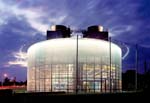 Peter Aaron/Esto University of Pennsylvania Mod 7 Chilled Water Plant, Philadelphia, PA: An elliptical metal screen wall encloses rectilinear glazed walls of the chiller plant building and truck turning areas.  Peter Aaron/Esto UPenn: At night, the illuminated screen wall emphasizes the southern gateway to the university from the bridge.  Peter Aaron/Esto UPenn: The irregularly shaped site, containing the separate chiller plant and baseball field precincts, is surrounded by the Schuylkill River, roadways, and railroad tracks. 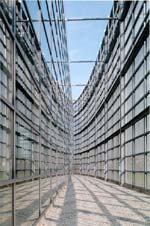 Peter Aaron/Esto UPenn: View of inner glass curtain wall and outer perforated stainless steel screen. 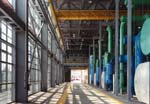 Peter Aaron/Esto UPenn: Chiller equipment, crane rail, and traffic ways are color coded for safety.  Leers Weinzapfel Associates UPenn: Site plan  Leers Weinzapfel Associates UPenn: Screen wall and building wall detail 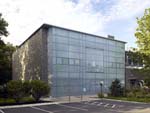 Alan Karchmer/Esto Princeton University Chilled Water Plant Expansion, Princeton, NJ: On the uphill side, the building's translucent glazed face provides ground-level entrance to a staff mezzanine, maintenance access to the upper equipment floor, and screens rooftop equipment added to the existing building beyond. 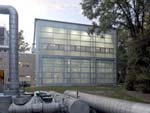 Alan Karchmer/Esto Princeton: The downhill translucent glazed face of the building provides truck access to three tall, ground-floor chiller bays and operable windows in the upper equipment floor. 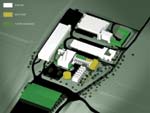 Leers Weinzapfel Associates Princeton: Site plan  Leers Weinzapfel Associates Princeton: Campus plan  Leers Weinzapfel Associates Ohio State University East Regional Chilled Water Plant, Columbus, OH: View looking north of the painted aluminum screen wall. 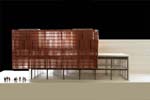 Leers Weinzapfel Associates OSU: View looking west highlights the glazed chiller volume and the perforated cooling tower volume. 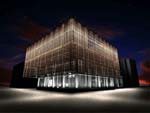 Francis Krahe & Associates OSU: llumination at night displays equipment and provides site lighting along the pedestrian path to campus. 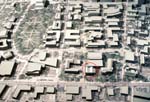 Leers Weinzapfel Associates OSU: Site model |
© 2012 ArchNewsNow.com